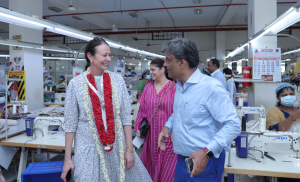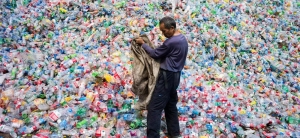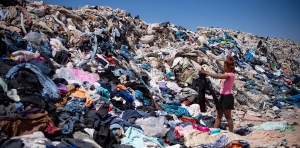5 Ways Your Choice of Carrier Bag Affects Environmental Sustainability
[vc_row][vc_column][vc_column_text]
How to minimise damage to the planet while you shop
There is little doubt that human activity and its unprecedented rate of convenience-driven consumption is having a serious effect on the environment. Whilst issues such as rising sea levels, dwindling wildlife species and melting icecaps seem daunting and too large to deal with on our own, there are practices that we as consumers can adopt that can make a real difference.
A very manageable place for us to start is to change the way we transport the goods we buy from one place to another. Since before money and shopping even existed, humans would have used some form of bag to carry goods between places. In times gone by, bags were made from natural fibres such as paper or cloth, and this remained relatively unchanged until the 1950’s when single use plastic bags made their debut in shops and homes alike. These bags became popular because they were strong, water-proof and very cheap to produce. They were made of an exciting and convenient new material whose impacts were unknown.
Fast forward almost 70 years, and those original plastic bags are still here – probably lurking in an ocean or landfill and releasing harmful greenhouse gasses such as Methane (which is 28 times more potent than CO2) as they try (and fail) to biodegrade. In fact Polyethylene (the synthetic polymer that most single use plastic bags are made of) takes centuries to biodegrade and this means that every plastic bag that humanity has ever created is still here in some way.
Recent media coverage and the war on plastic has left most of us feeling guilty, worried and keen to change. And it’s no wonder! It is estimated that by the end of 2018, 5 trillion plastic bags will have been used worldwide this year alone: that works out at a staggering 160,000 per second! Government initiatives are attempting to tackle the problem through deterrence – but surely there’s a better way than struggling home with armfuls of precariously balanced groceries to avoid spending 5p on a plastic bag. Here are five things to consider when choosing how to transport your shopping:
1. Fibre content – what the bag is made of
The first environmental impact of a carrier bag comes with the choice of raw material for making it. Natural or synthetic, each fibre carries its own cluster of environmental impacts.
- Natural fibres – these include paper, cotton, hemp and jute. They are renewable, biodegradable and are not derived from synthetic petrochemicals. Natural fibres are grown using varying quantities of water and land – and are sometimes grown using chemical additives such as fertilisers or pesticides.
- Synthetic fibres – these usually have scary scientific names such as polypropylene or polyethylene and are usually a form of plastic. They are non-biodegradable and typically made of synthetic polymers that started life as non-renewable petrochemicals. These fibres are strong and durable – which is why they struggle to biodegrade. Petroleum extraction can have a large number of negative effects on the natural world; however, producing plastic does require less water and land than growing natural fibres.
Conclusion: try to opt for natural fibres where you can, but remember that synthetic fibres last for a very long time and if you re-use them their environmental impact will be somewhat reduced.
2. Fibre production – how the fibre is produced
It’s very easy to believe natural fibres are the solution because they biodegrade and don’t rely on petroleum extraction, but it is important to consider how those fibres came to be:
- How much water was used, wasted and/or polluted to produce a fibre?
- Whether or not chemicals were used in their production, and if so which chemicals?
- How much land was required for its production, or was it created in a science lab?
Cotton, for example, is one of the most frequently used natural fibres on earth, but it is also one of the thirstiest crops. According to the World Wildlife Fund, it takes approximately 20,000 litres of water to produce around 1kg of cotton (equivalent to a single t-shirt and a pair of jeans). Even if the cotton is grown organically, do issues such as soil degradation, droughts and desertification perhaps outweigh cotton’s biodegradability?
On the other hand, hemp can produce up to 250% more usable fibre than cotton using the same area of land, much less water and without any need for chemical pesticides or fertilisers. Not only that, but hemp is leafier than cotton and absorbs more CO2 and thus releases more oxygen during its growth.
Conclusion: try to avoid natural fibres that are grown using chemical pesticides and fertilisers, and remember that organic cotton is not a flawless solution for the plastic bag problem.
3. Bag design & production
Once the fibre content and its production are established, the next steps are design and production. Try to consider whether your carrier bag has been designed as disposable and single-use, or if it has been designed to last and be reused multiple times. The mass-production of anything generally requires a factory and factories of course use large quantities of energy and can generate large volumes of emissions. There are reusable carrier bags on the market that are made in factories that operate under Fairtrade certification and use environmentally friendly production methods.
Conclusion: try to find a reusable carrier bag that has been made by a brand that considers carbon emissions and energy use in their factory. However, if this is not an option then make sure you use your bag as much as you can so that is offsets some of the energy used and emitted during its production.
4. Consumer use – how you use the bag
It is very easy for us consumers to criticise the big brands and hold them accountable for the startling state of our planet’s health. However, sustainability is the responsibility of the producer and the consumer. After all – every time we buy something, we are making a choice and effectively voting with our money. If we want to stem plastic bag production then we must do our bit to consume fewer plastic bags. Without a demand, there is no reason to supply.
By opting for a reusable carrier bag you can dramatically reduce your plastic footprint and even avoid non-biodegradable plastic waste entering landfill. Not only that, but every time you use your reusable bag, you are in effect giving it another life. This is an economical use of the time, resources and energy that were used in its production, and also lessens the demand for virgin single use plastic bags.
Conclusion: whatever your carrier bag is made from, use it, reuse it and use it again. If we want to improve environmental sustainability and detach ourselves from this notion of disposable single use plastics, then we must stop prematurely throwing things away and use them as much as we can.
5. End of use – what happens when you’ve finished using it
What happens at this stage of a carrier bag’s life is largely determined by the first stage of its life – fibre content. When a natural fibre is disposed of, it will react with the elements and eventually break down organically. However, when a synthetic fibre enters landfill it will try to degrade in the same way as a natural fibre but because the polymer chains are synthetic and strong, they will take centuries to break down – if ever. To make matters worse, because synthetic fibres are usually forms of plastic made from petrochemicals, harmful greenhouse gasses will be released from throughout the duration of a synthetic fibre’s attempted break down. This problem can be addressed by recycling all plastic bags, however it is estimated that less than 10% of recyclable carrier bags are actually recycled.
Conclusion: this stage of the life of a carrier bag really highlights the importance of a well-chosen fibre. Indeed, it is possible to minimise the environmental impact caused during the previously mentioned stages, but if a material enters landfill and remains there for hundreds of years constantly releasing toxic gasses into the atmosphere, then surely that can’t be a good thing. Try to use natural fibres where you can, because although disposal is the last stage of a carrier bag’s life, it is undoubtedly one of the most significant.[/vc_column_text][/vc_column][/vc_row]




